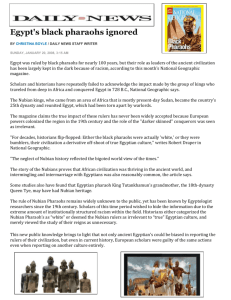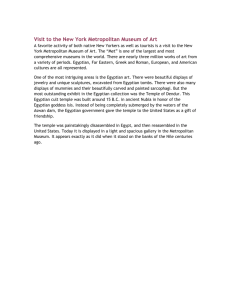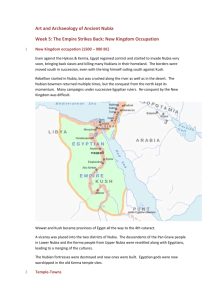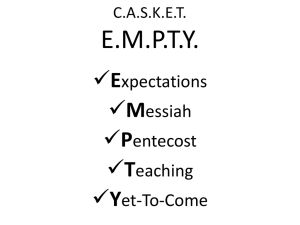Unit 6 - course notes
advertisement
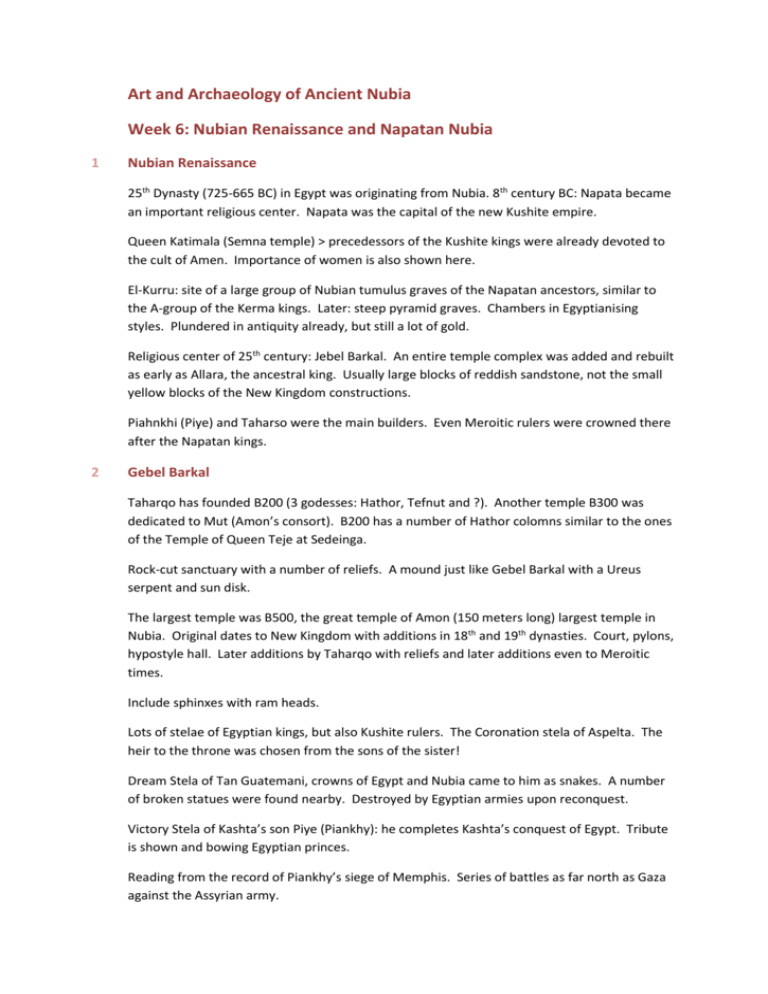
Art and Archaeology of Ancient Nubia Week 6: Nubian Renaissance and Napatan Nubia 1 Nubian Renaissance 25th Dynasty (725-665 BC) in Egypt was originating from Nubia. 8th century BC: Napata became an important religious center. Napata was the capital of the new Kushite empire. Queen Katimala (Semna temple) > precedessors of the Kushite kings were already devoted to the cult of Amen. Importance of women is also shown here. El-Kurru: site of a large group of Nubian tumulus graves of the Napatan ancestors, similar to the A-group of the Kerma kings. Later: steep pyramid graves. Chambers in Egyptianising styles. Plundered in antiquity already, but still a lot of gold. Religious center of 25th century: Jebel Barkal. An entire temple complex was added and rebuilt as early as Allara, the ancestral king. Usually large blocks of reddish sandstone, not the small yellow blocks of the New Kingdom constructions. Piahnkhi (Piye) and Taharso were the main builders. Even Meroitic rulers were crowned there after the Napatan kings. 2 Gebel Barkal Taharqo has founded B200 (3 godesses: Hathor, Tefnut and ?). Another temple B300 was dedicated to Mut (Amon’s consort). B200 has a number of Hathor colomns similar to the ones of the Temple of Queen Teje at Sedeinga. Rock-cut sanctuary with a number of reliefs. A mound just like Gebel Barkal with a Ureus serpent and sun disk. The largest temple was B500, the great temple of Amon (150 meters long) largest temple in Nubia. Original dates to New Kingdom with additions in 18th and 19th dynasties. Court, pylons, hypostyle hall. Later additions by Taharqo with reliefs and later additions even to Meroitic times. Include sphinxes with ram heads. Lots of stelae of Egyptian kings, but also Kushite rulers. The Coronation stela of Aspelta. The heir to the throne was chosen from the sons of the sister! Dream Stela of Tan Guatemani, crowns of Egypt and Nubia came to him as snakes. A number of broken statues were found nearby. Destroyed by Egyptian armies upon reconquest. Victory Stela of Kashta’s son Piye (Piankhy): he completes Kashta’s conquest of Egypt. Tribute is shown and bowing Egyptian princes. Reading from the record of Piankhy’s siege of Memphis. Series of battles as far north as Gaza against the Assyrian army. 3 Assyrian Conflict, Shawabti Figures and Carlos Conservation Lab Shabako followed Piye: he cemented the dynasty against a rebellion from the delta. He moved the capital to Memphis. The Shabako stone is a religious treatise from his reign: creation myths. He continues to battle against the Assyrians. His son Shebitku tried to reason with Assur, but to no avail. He and his brother Taharqa campaigned against Sennecherib’s expansion. 690 BC: Taharqa follows Shebitku. Taharqa is mentioned in the bible as king of Ethiopia. He was a great builder in Karnak and Gebel Barka. The kings dedicated statues in bronze and stone. Often the emblems of the25th dynasty were removed later on: Rams head, double ureus and sun disk. The conflict with the Assyrians continued and they were probably helped by the Delta princes against the Kushite dynasty. 671 BC Memphis is conquered: Taharqa retreated to Thebes when Assurbanipal moved southwards through Egypt. After Taharqa, Shabaka’s son Tan Guatamani or Tantamani followed as the last king of the 25 dynasty. He tried to retake Memphis, but the Assyrians rebutted him and sacked Thebes. He returned to Napata, where he chose Nuri as the site of a new cemetery. Nubian pharaohs had thousands of Shawabtis in their pyramids. For many of the Nubian kings, these shawabtis are the only records we have of their reign Even later, the Nubian kings continue to be buried in pyramids, calling themselves “king of upper and lower Egypt”. The tombs have lots of grave goods. Review of a small Napatan bronze statue and a thumb stone in the lab. 4 Art & Architecture of the 25th Dynasty The Nubian dynasty brought a new life to the Egyptian art – some of the greatest art and architecture was created in this period of a hundred years. Deir Bahri shows some of these exemples. Tomb of Mentuemhet mayor of Thebes: the largest private tomb in Egypt, right in front of Hatshepsut’s temple. Above ground: mudbrick pylon with an arch an a pyramid. There are over 50 rooms with lots of reliefs in earlier styles. Sunken court with archaeic period decorations. The tomb was plundered but the carvings can be found still in diverse museums. Nubians were observant of Egyptian art and applied them to a large degree. They understood the phases in Egyptian art and applied them correctly. Interest in more exotic stones aside from the more standard materials. Architecture: lots of standards of later periods appear in the 25th dynasty. Kiosks appear. In response to widespread robbery of tombs, at the end of the New Kingdom more and more new tombs are placed in temple districts for protection. Divine consort were usually female relatives. The Amon priesthood was thus loyal to the royal dynasty. Then Piye invaded Egypt, Shepenwepet was divine consort who adopted Amenirdis (Kashta’s daughter) who then became divine consort after her death. Egyptian coffin faces evoke the face of the ruling king. Under Napatan kings: dark skin and wide faces, earlier: yellow and narrow (Libyan dynasty). Period of prosperity leads to much better and more expensive materials for the coffins. 5 25th Dynasty Sculpture Also colossal sculpture in stone comes to the fore. Distinctive: narrow furrow between corner of mouth and nose. The Nubian headdress is also en vogue. Lots of statues at Gebel Barkal that had been destroyed and given a burial in sacred grounds. Arte video about Charles Bonnet, a Swiss archaeologist in Sudan. More destroyed statues were found in Dangeil (near 5th cataract), but it is debatable why they were destroyed. Probably the Egyptian campaign in 591. The Napatan palace and many temples were destroyed by Semtec of Egypt. Later pieceful relations were re-established. Maybe this was the reason for the move of the capital to Meroe. B Discussion: a What lasting effects did the 25th Dynasty have on Egyptian culture? One of the main effects was probably the revival of a feeling of art and architecture and a new understanding of what characterises different periods of Egyptian culture in the different periods before. The Nubian kings revitalised this area by bringing an outsider’s view (with a large smattering of knowledge through earlier influences from the north) to the field. One could also argue that the100 years of Nubian dynasty have pulled together the forces in Egypt proper to form a single block to reinvent themselves politically and culturally.
